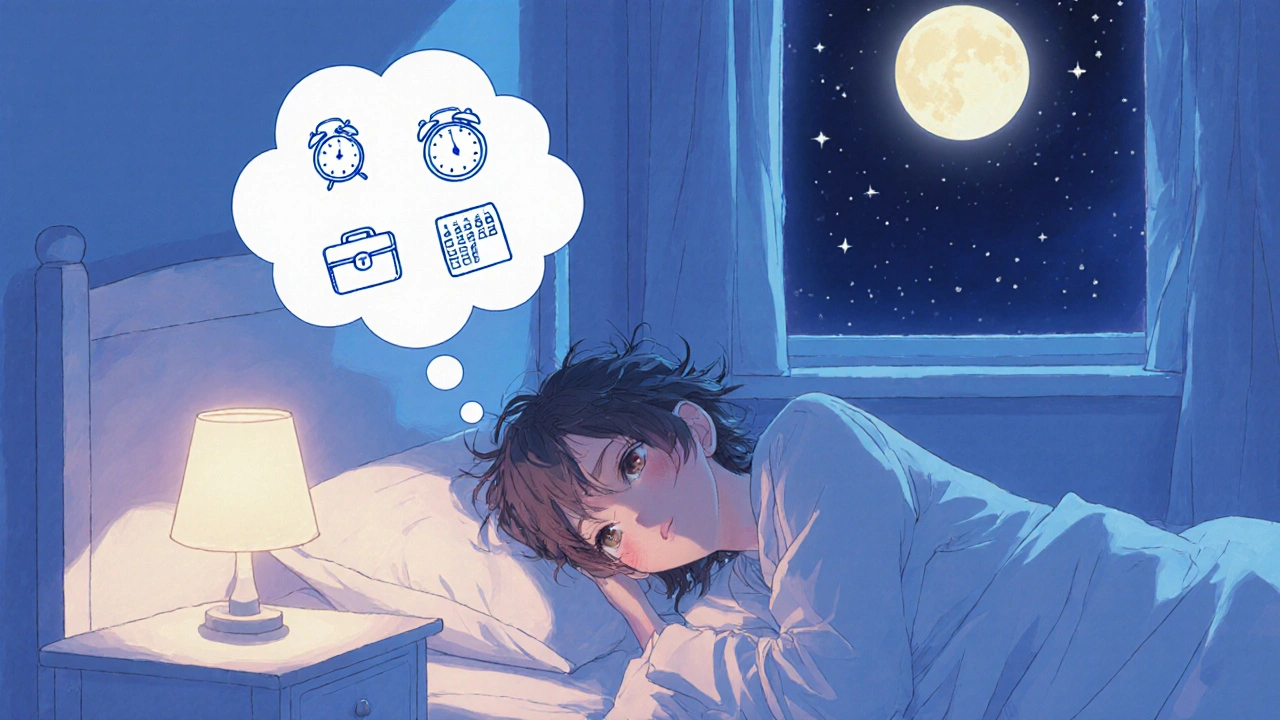CBT-I Sleep Restriction Calculator
How Sleep Restriction Works
In CBT-I, sleep restriction limits time in bed to match your actual sleep time. As sleep efficiency improves (time asleep ÷ time in bed), your sleep window gradually expands.
Goal: Maintain 85%+ sleep efficiency to expand your sleep window.
Struggling to fall asleep night after night? You’re not alone. Millions of adults deal with insomnia, and many turn to pills that only work short‑term. Cognitive Behavioral Therapy for Insomnia is a science‑backed alternative that attacks the problem at its root, reshaping the thoughts and habits that keep you awake. Below you’ll learn why it works, what the core components are, and how you can start seeing real sleep‑quality improvements.
What Exactly Is CBT‑I?
CBT‑I stands for Cognitive Behavioral Therapy for Insomnia. It’s a short‑term, goal‑oriented psychotherapy that combines two proven tracks:
- Cognitive - identifying and challenging unhelpful beliefs about sleep (e.g., “If I don’t get eight hours, I’ll be useless tomorrow”).
- Behavioral - changing daily routines that reinforce wakefulness, such as spending hours in bed scrolling.
The approach was first formalized in the 1980s, and dozens of clinical trials since then show it can reduce sleep onset latency by an average of 30‑40 minutes and increase total sleep time by 1‑2 hours.
Why CBT‑I Beats Medication for Most People
Prescription sleep meds work by depressing the central nervous system. They can help you nod off, but they often cause grogginess, tolerance, and dependence. In contrast, CBT‑I offers lasting change without side effects. Here are the biggest advantages:
- Durable results - improvements typically persist six months or more after the program ends.
- No next‑day drowsiness - because you’re not chemically sedated.
- Addresses underlying anxiety - many insomniacs also battle worry; CBT‑I tackles both.
- Cost‑effective - a handful of sessions cost less than a year’s supply of pills.
For people with chronic insomnia (symptoms >3 months), the American Academy of Sleep Medicine lists CBT‑I as the first‑line treatment.
Core Components of a CBT‑I Program
A typical CBT‑I course runs 6‑8 weekly sessions, each lasting 45‑60 minutes. The therapist guides you through a set of evidence‑based techniques. Below is a quick snapshot of the most common tools.
- Sleep restriction - limits the time you spend in bed to match the actual amount you sleep, gradually expanding as efficiency improves.
- Stimulus control - teaches you to associate the bedroom with sleep, not wakefulness (e.g., leaving the room if you can’t fall asleep within 20 minutes).
- Sleep hygiene - outlines lifestyle changes like limiting caffeine after 2 p.m., keeping the room cool, and establishing a wind‑down routine.
- Cognitive restructuring - helps you spot catastrophizing thoughts about sleep and replace them with realistic statements.
- Relaxation training - introduces progressive muscle relaxation, deep‑breathing, or guided imagery to lower physiological arousal.
- Sleep diary - a daily log of bedtime, wake‑time, night awakenings, and daytime alertness that fuels therapist feedback.
Each technique builds on the others, forming a comprehensive plan that reshapes both mind and habit.
Step‑by‑Step Guide to Starting CBT‑I
If you’re ready to give CBT‑I a try, follow this practical roadmap.
- Find a qualified therapist. Look for credentials such as “Certified Sleep Psychologist” or “Licensed Clinical Psychologist with CBT‑I training.”
- Complete a baseline sleep diary for at least one week. Record when you go to bed, when you fall asleep, awakenings, and how you feel in the morning. \n
- Attend the first session. The therapist will review your diary, screen for other sleep disorders (e.g., sleep apnea) and set a realistic target sleep window (usually 5‑6 hours for beginners).
- Implement sleep restriction. If you average 5 hours of sleep, schedule your time in bed for 5‑5.5 hours. Stick to the schedule, even on weekends.
- Practice stimulus control. Only use the bed for sleep (and sex). If you’re awake after 20 minutes, get up, do a quiet activity, and return when sleepy.
- Apply cognitive restructuring. Write down worries (e.g., “I’ll miss my meeting”) and challenge them with evidence (“I’ve prepared well; a few minutes of fatigue won’t ruin it”).
- Integrate relaxation training into your bedtime routine-5 minutes of diaphragmatic breathing works for most people.
- Review progress weekly with your therapist, adjusting the sleep window as efficiency improves (aim for >85% efficiency before expanding).
Most clients notice measurable improvement by week 3, with full benefits emerging around weeks 6‑8.

How CBT‑I Compares to Common Alternatives
| Factor | CBT‑I | Sleep Meds (e.g., zolpidem) |
|---|---|---|
| Onset of benefit | 2‑3 weeks | Within 30 minutes |
| Long‑term efficacy | 6‑12 months+ (often persistent) | Declines with tolerance |
| Side‑effects | None | Drowsiness, dependency, rebound insomnia |
| Cost (US$ per year) | ~$600‑$900 (8‑10 sessions) | ~$1200‑$1800 (ongoing prescription) |
| Impact on next‑day alertness | Improved | Often reduced |
| Addresses underlying anxiety/depression | Yes | No |
The table makes it clear: CBT‑I may take a bit longer to kick in, but the payoff is safer, cheaper, and lasting.
Who Benefits Most From CBT‑I?
While anyone with trouble sleeping can try CBT‑I, certain groups see especially strong gains:
- Adults with chronic insomnia - symptoms >3 months, often accompanied by stress.
- People with comorbid anxiety or depression - CBT‑I’s cognitive tools reduce rumination that fuels both mood and sleep problems.
- Shift workers - tailored sleep‑window adjustments help reset circadian misalignment.
- Seniors - they are more vulnerable to medication side‑effects; CBT‑I offers a non‑pharmacologic route.
Those with untreated sleep apnea or restless‑leg syndrome should first receive appropriate medical management, then add CBT‑I for residual insomnia.
Potential Pitfalls & How to Avoid Them
Even the best therapy can stumble if you miss a key step.
- Skipping the sleep diary - without data, the therapist can’t personalize restrictions. Keep the diary digital or paper, and fill it out nightly.
- Inconsistent bedtime - irregular schedules dilute restriction benefits. Aim for the same lights‑out time each night, even on weekends.
- Giving up after a few sleepless nights - initial weeks may feel rough as your body adjusts. Trust the protocol; most setbacks resolve by week 4.
- Using the bedroom for work or TV - this breaks stimulus control. Reserve the room strictly for sleep and intimacy.
When you notice a slip, contact your therapist promptly. Minor tweaks (e.g., adjusting the sleep window by 15 minutes) keep you on track.

Real‑World Success Stories
Here are three concise case snapshots that illustrate typical outcomes.
- Emily, 34, marketing manager - 8 weeks of CBT‑I cut her sleep onset from 90 minutes to under 15 minutes. She stopped using over‑the‑counter melatonin.
- James, 58, retired veteran - after a failed trial of benzodiazepines, CBT‑I lowered his nighttime awakenings from 5 to 1 per night and eliminated morning grogginess.
- Lina, 27, graduate student - combined CBT‑I with mild exercise; her total sleep time rose from 5.5 hours to 7 hours, and her anxiety scores dropped by 30%.
All three followed the same core steps, showing that CBT‑I works across ages, lifestyles, and stress levels.
Getting Started in 2025: Options Near You
Perth now hosts several clinics offering CBT‑I, both in‑person and via telehealth. A quick search for “CBT‑I Perth” yields government‑funded public health services and private psychologists. If travel is a barrier, online platforms like Sleepio and DOSE (Digital Open Sleep Education) provide guided programs that mimic therapist‑led sessions.
When choosing, verify that the provider follows the American Academy of Sleep Medicine’s CBT‑I protocol or the Australian Sleep Association’s guidelines. Insurance plans often cover up to 8 sessions; check your benefits before booking.
Key Takeaways
In a nutshell, cognitive behavioral therapy insomnia offers a proven, side‑effect‑free path to better sleep. By swapping nightly pills for a structured program that rewires thoughts and habits, you gain lasting rest, sharper daytime focus, and lower risk of mood disorders. Give it a try-your future well‑rested self will thank you.
How long does a typical CBT‑I program last?
Most programs run 6‑8 weekly sessions, each lasting about an hour. Some providers offer intensive 3‑day formats, but the core techniques stay the same.
Do I need a therapist, or can I do CBT‑I on my own?
A trained therapist tailors the protocol, monitors progress, and adjusts limits safely. Self‑guided apps can be helpful for mild insomnia, but they lack personalized feedback and may miss comorbid conditions.
Is CBT‑I covered by health insurance in Australia?
Many private health funds reimburse psychology services, including CBT‑I, up to a certain number of sessions. Public hospitals may also provide it at no cost if you meet clinical criteria.
Can CBT‑I help with occasional “stress‑related” sleeplessness?
Yes. Even short bursts of stress trigger the same maladaptive thoughts that fuel chronic insomnia. Applying stimulus control and relaxation techniques can quickly restore normal sleep patterns.
What if I have another sleep disorder, like sleep apnea?
Treat the primary disorder first (e.g., CPAP for sleep apnea). Once breathing is stable, CBT‑I can address residual insomnia that often remains.


John Price
October 21, 2025 AT 19:17Just read the rundown-CBT‑I sounds like a solid, drug‑free fix for sleepless nights.
eric smith
October 23, 2025 AT 12:57Oh, great, another "miracle cure" that’ll magically melt your insomnia away-because we all know therapists have endless free time.
In reality, you’ve got to stick to the schedule, log every night, and actually change habits, not just hope for a mystical reset.
Ericka Suarez
October 25, 2025 AT 06:37Listen up, folks – CBT‑I is the real battle plan for those sleepless nights that drag you into the abyss of mediocrity!
Forget the pop‑pill nonsense; this therapy re‑programs your brain like a national security upgrade.
Even if your mind feels like a broken record, the structured sessions will march it into line.
It’s simple: think smart, act smart – no more tossing and turning like a ship lost at sea.
And for the naysayers, that’s just lazy propaganda.
Angela Koulouris
October 26, 2025 AT 14:57Hey, you’re already on the right track by considering CBT‑I – that’s a huge win!
Stick to the sleep diary, keep the bedroom cue‑only rule, and give yourself credit for each small win.
Remember, consistency beats perfection, so don’t get discouraged if the first week feels rough.
You’ve got this, and the better sleep will follow.
Sakib Shaikh
October 28, 2025 AT 03:04Alright folks, let me break it down – CBT‑I works because it attacks the two main villains: a chaotic mind and lax habits.
You start by cutting your time in bed to match actual sleep – that’s the “sleep restriction” trick.
Then you enforce stimulus control: no phones, no reading, just the bed for sleep.
Don't forget the cognitive part – challenge those catastrophic thoughts like "If I sleep less I’ll crash at work".
Combine these steps and you’ll see the data shift – less latency, longer total sleep.
Stick to the plan, and the brain rewires itself automatically.
Vivian Annastasia
October 29, 2025 AT 12:24Sure, the therapist will hand you a sweet little sleep diary, but then you’re expected to be a model citizen and fill it out every night – like that’s easy when you’re staring at the ceiling.
And the whole “relaxation training” thing? Yeah, try calming your mind after three cups of coffee and a deadline.
Nick M
October 31, 2025 AT 00:30Let’s be honest, the whole CBT‑I hype is just another way for the “sleep industry” to sell you worksheets and charge for “premium” sessions.
They’ll tell you it’s science, but the real secret is that they’re manipulating your data to keep you coming back.
In the meantime, you could just turn off the lights and hope for the best – cheaper than any therapist.
Jake Hayes
November 1, 2025 AT 09:50Data shows CBT‑I consistently outperforms medication in long‑term outcomes.
If you skip the homework, you won’t see the benefits.
parbat parbatzapada
November 2, 2025 AT 21:57They say CBT‑I is “evidence‑based,” but who’s really watching the lab? Probably the same people who push flavored water as a miracle drink.
Don’t be fooled – you’ll end up tracking every minute of your life in a diary and still wake up feeling like a zombie.
It’s a trap designed to keep you dependent on “expert” advice.
Casey Cloud
November 4, 2025 AT 07:17Honestly CBT‑I can be a game changer if you stick to the basics like limiting caffeine and keeping a consistent sleep window it’s worth trying even if you’re skeptical
Ivan Laney
November 5, 2025 AT 19:24Let me set the record straight: CBT‑I isn’t just another trendy self‑help fad; it’s a rigorously validated, frontline treatment that has fundamentally reshaped how we approach chronic insomnia.
First, the therapy’s core premise-identifying and restructuring maladaptive sleep‑related cognitions-directly challenges the pervasive narrative that sleeplessness is merely a by‑product of stress, instead positioning it as a modifiable behavioral pattern.
Second, the behavioral component, namely sleep restriction and stimulus control, forces the brain to realign its homeostatic drive, effectively resetting the sleep‑wake cycle without reliance on pharmacology.
Third, the evidence base is robust: meta‑analyses consistently report an average reduction of sleep onset latency by 30‑40 minutes and an increase in total sleep time by one to two hours, effects that endure for six months or more after treatment cessation.
Fourth, from a public health perspective, CBT‑I is cost‑effective; a handful of therapist‑guided sessions typically cost less than a year’s supply of hypnotic medication, reducing both direct financial burden and the societal costs tied to medication dependence and side‑effects.
Fifth, the therapy’s portability-delivered in‑person, via telehealth, or through validated digital platforms-means it can be scaled to reach underserved populations, a critical advantage in our increasingly remote world.
Sixth, the integration of cognitive restructuring tackles the often‑overlooked comorbidities of anxiety and depression, delivering collateral mental‑health benefits that pharmacologic interventions rarely achieve.
Seventh, CBT‑I aligns with the American Academy of Sleep Medicine’s guidelines, designating it as the first‑line treatment for chronic insomnia, a testament to its standing within the professional community.
Eighth, the therapeutic alliance formed during CBT‑I sessions empowers patients with self‑efficacy; they acquire lifelong skills-relaxation techniques, sleep hygiene, and diary tracking-that transcend the immediate treatment window.
Ninth, while the initial weeks may feel challenging due to sleep restriction, the protocol’s systematic titration ensures progressive improvements without the rebound insomnia often seen with abrupt medication cessation.
Tenth, the widespread adoption of CBT‑I in nations with universal healthcare, such as the United Kingdom and Australia, underscores its global relevance and adaptability.
Eleventh, for shift workers and seniors, tailored modifications within the CBT‑I framework address circadian misalignment and heightened medication sensitivity, respectively.
Twelfth, the therapy’s emphasis on data‑driven adjustments-relying on sleep diaries and objective sleep efficiency metrics-creates a feedback loop that minimizes guesswork.
Thirteenth, the cumulative body of research, spanning decades and diverse populations, solidifies CBT‑I’s status as the gold standard for non‑pharmacologic insomnia treatment.
Fourteenth, as we confront escalating concerns about prescription drug overuse, CBT‑I stands as a viable, evidence‑based antidote.
Fifteenth, in short, if you’re seeking sustainable, side‑effect‑free improvements in sleep quality, CBT‑I is the scientifically vetted path forward.
Eli Soler Caralt
November 7, 2025 AT 04:44In the grand tapestry of nocturnal cognition, CBT‑I emerges as a veritable loom, weaving together threads of belief and behaviour into a harmonious slumber.
One might argue that the mind, in its infinite complexity, resists such linear interventions, yet empirical data whispers a different tale. 🌙
Thus, let us not dismiss the subtle alchemy of restructuring thoughts as mere pomposity; it is, after all, the quiet architect of repose. 💤
Eryn Wells
November 8, 2025 AT 16:50Hey everyone! 🌟 CBT‑I is a fantastic option that anyone can try, regardless of background.
Remember to be kind to yourself during the process – progress takes time. 🌙
Feel free to share any tips you discover – we’re all in this together! 😊
Kathrynne Krause
November 10, 2025 AT 02:10Absolutely love seeing the conversation on CBT‑I! 🎉 Keep the momentum going and celebrate every small win – whether it’s falling asleep faster or waking up refreshed.
Let’s keep encouraging each other to prioritize sleep health.